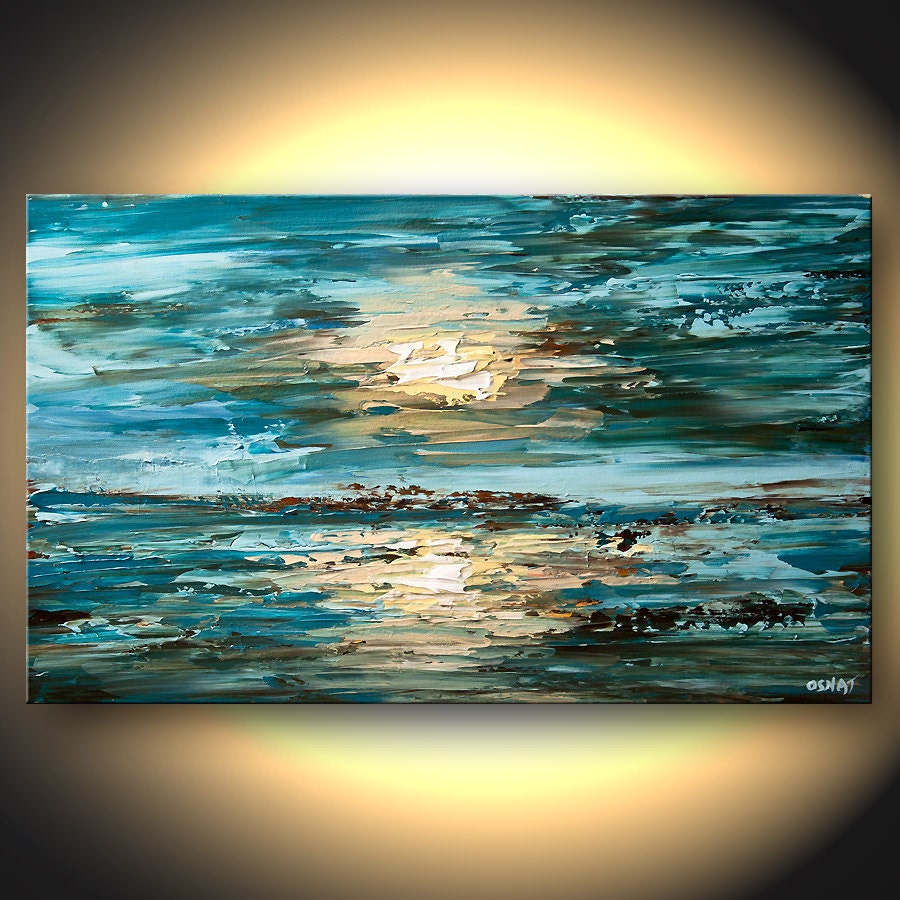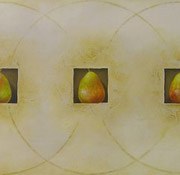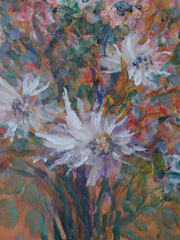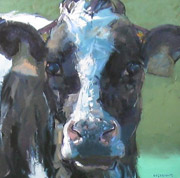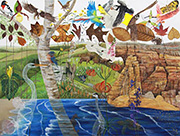L’exposition d’Irene F. Whittome titree <<Consonance>> comprenait sept oeuvres, soit deux pieces datant de 1976 et cinq autres beaucoup plus recentes, de 1994-1995. Comme le titre, <<Consonance>>, l’indique deja d’entree de jeu, il y a une dimension sonore, musicale, importante rattachee a cette exposition (dont la commissaire fut Joyce Yahouda). De facon precise, explicite, les quatre oeuvres de 1995 font toutes reference au son, a la musique.
Pause; Fermata (1995) presente une Kannon Bouddha en bronze (ou Bouddha feminin), installee sur une sorte de petit chariotsocle, les pieds de la statue comme tels reposant sur trois plaques carrees de verre. Disposes chacun a egale distance de la tete de cette Kannon Bouddha, deux hautparleurs diffusent, a intervalles de seize secondes, des sons de verre qui se brise (soit huit sequences differentes, bien qu’apparentees, de sons de verre brise, reunies en boucle). Ce son de verre surgit, a chaque fois, de maniere abrupte, nous atteint soudainement, nous frappe, nous heurte, nous bouscule, coup de verre cassant, blessant, brutal. Chaque sequence est plutot courte, suivie d’une pause-silence, puis d’autres sons de verre, d’une autre pausesilence, et ainsi de suite, sans fin. (<<Fermata>>, incidemment, signifie pause en musique.)
Il n’y a pas de lien fluide, narratif ou dialectique entre tous ces sons, qui formerait une trame bruitiste, concrete, musicale. Il n’y a pas de dialogue entre les sequences, de continuite de l’une a l’autre, une sorte de suivi acoustique, si on veut. Le son diffuse reste toujours abrupt, soudain, dur, ephemere. Il reste un bruit, un bruit de verre qui se casse, qui se brise sans jamais chercher pour autant a se developper, a se structurer dans le temps, comme une musique a part entiere.
Mais commencons par le commencement et retournons sur nos pas, au tout debut de l’exposition. La premiere oeuvre qu’on aborde d’emblee, qui nous barre la route en quelque sorte et qu’il faut contourner, a pour titre Consonance; Dissonance (1995). Le verre comme materiau-cle est present, au depart, dans cette oeuvre, sous la forme d’une table au plateau de verre trempe et aux pattes de verre souffle. Cette table de verre de Whittome supporte un ensemble de boites en carton, de format identique, recouvertes de platre blanc. Ces boites empilees proprement, a la verticale, forment comme un autel asymetrique, sinon un petit temple avec sourdine integree, en guise d’ouverture. Le verre, d’emblee, s’impose ici comme materiau-cle, incontournable, le verre fragile, cassant par definition, et qui nous communique bien cette idee de precarite, d’ephemere qui soustend toute forme de vie, d’existence (et toute l’exposition de l’artiste ici).
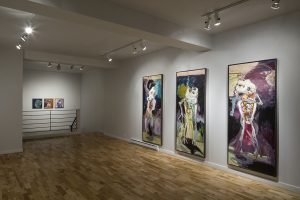
Bien qu’il y ait un aspect dramatique ou theatral au travail de Whittome, il ne faut pas sousestimer, pour autant, son aspect ludique, interactif, son invitation au jeu, a re-creer son oeuvre, a la reinventer. A cet egard, l’immense Clavier en deux sections complementaires qu’elle nous donne a voir, en face-a-face, dans la premiere salle du CIAC, incite a une telle reflexion. De quoi s’agit-il?
Le grand Clavier (1995) vertical, a droite, est constitue de dixneuf longs panneaux de verre trempe, installes en angle contre le mur. Appuyes contre eux, on peut voir, inclines, dix-huit autres panneaux d’encaustique et de bois, de meme taille, auxquels sont integrees, tels de petits tableaux en noir et/ou blanc, des masses rectangulaires toutes de meme dimension, en papier moule, qui representent un peu les touches du Clavier, reposant sur une infrastructure de verre a faire resonner.
Clavier est une oeuvre silencieuse, immobile, paisible, dans l’attente. Elle recele son propre drame. Elle dissimule sa tempete. C’est une oeuvre d’implosion, de violence contenue, etouffee, empechee. Une oeuvre de facade, en apparence. Car on peut facilement passer a cote, n’y voir que beaute esthetique et froideur. Vertige glace. Ce serait la le resultat d’un premier regard trop rapide, d’une premiere lecture. Mais Clavier prend tout son sens vu dans le contexte global de l’exposition, en dialogue avec Pause; Fermata, avec ce double sonorise, audible. Il faut aussi ouir Clavier, mais autrement.
Clavier; Notes (1995), son complement, associe vingt-deux oeufs d’autruche vides positionnes tres haut, en ligne, au mur, a des notes de musique, alors que Contredanse (1995) evoque le corps (la peau, les os), via de vieux sacs de toile suspendus et de longues tiges maigrelettes en bois, sinon en metal (recouvertes, celles-ci, de bandelettes de platre blanc).
Suivent, installes au mur, a l’horizontale, 24 objets entoures de fil metallique (1976), chacun comprenant deux petits rouleaux identiques de papier moule, verticaux et blancs (obtenus d’apres une impression de cordes et ressemblant, eux aussi, a des os), retenus par une mince feuille de papier moule et entoures de fil metallique. En serie, en ligne droite, chaque objet etant ressemblant et different de facture, c’est a la fois simple et depouille, clavier de cordes, clavier d’os, clavier de nerfs a vif, de poussiere en sursis.
Dans le meme espace, on peut voir, sur un autre mur (a gauche, en entrant), l’oeuvre photographique titree Autoportrait (1976). Il s’agit de neuf photographies sepia, toutes differentes mais apparentees, soit trois rangees de trois photographies chacune (sorte de clavier de photos), le tout etant inscrit dans un grand cadre noir (l’equivalent bidimensionnel, peut-etre, ici, d’une caisse de resonnance). Sur chaque photo (prise par Whittome elle-meme), on peut voir la main gauche ficelee de l’artiste, entouree de fil metallique (tout comme pour les 24 objets a proximite). Le corps donc est present via cette main ligotee, dominee, attachee, coincee, prisonniere, en cage. La main-visage, la main qui nous regarde. La main recele deja tout un univers en soi. Elle contient tout, le passe, le present, l’avenir. On la lit, on la regarde, on la choregraphie, on la peint, on la sculpte, on l’ecoute. On s’y voit, on s’y devine, on s’y entend, Tout est dans la main deja, ou presque. Et si on la rattache a la thematique de base de cette exposition nommee <<Consonance>>, si on se rappelle egalement le gigantesque Clavier en introduction, on ne peut pas s’empecher de penser, alors, a toutes ces mains de musiciens (et il n’y a pas de musique sans mains, enfin presque, car la voix est une <<main>> aussi), a toutes ces mains, donc, qui jouent des claviers divers, du piano, du clavecin ou tout autre instrument de cette meme famille.
Curio: Fantaisie-Fantasia-Fancy-Phantasterien (1994) est une installation silencieuse mais on entend, malgre tout, en la regardant in situ, au CIAC, les sons de verre brise, en provenance de l’autre salle adjacente hebergeant Pause; Fermata. On a donc, avec Curio, une tortue placee sur un dictionnaire, lequel repose a son tour sur un piedestal eleve, le tout expose dans un meuble vitre (ou curio). La tortue, la bouche ouverte, semble emettre comme un cri arrete dans le temps. A ses pieds, on peut voir des oeufs d’autruche (de grosses coquilles blanches evidees). Un grand disque de lumiere est egalement projete au mur du fond (une lumiere immaterielle comme la musique, le silence, le vent, l’ecoute).
Ce grand cri de tortue de Curio, on ne l’entend pas de fait. On peut, peut-etre, l’imaginer mais, surtout et avant tout, on le voit, un long cri sur la musique et aussi sur l’art, sur les mots, sur la culture en general, sur les gens par extension, les desherites du systeme, les pauvres, les marginaux, les exploites, les coinces, les bafoues, les violentes de partout, les abuses, les humilies, les immoles, les sacrifies, ici comme ailleurs, au jour le jour, un cri qui appelle la lumiere (ce que suggere peut-etre, deja, la projection circulaire au mur).
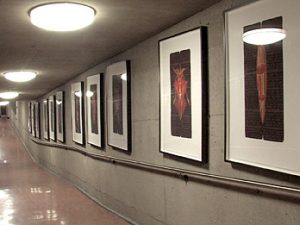
Ce cri visuel de tortue, il est donc contenu dans un meuble de verre. C’est un cri a vide, un cri sous verre, un cri etouffe, <<ficele>> comme la main de Whittome auparavant, un cri qu’on regarde et que le son de verre brise de la piece voisine, Pause; Fermata, libere enfin. Le verre vole en eclats et le cri s’echappe. Cette toute derniere oeuvre de 1995, Pause; Fermata, repond ainsi eloquemment a Curio de 1994. Tout fonctionne ici, dans la mise en place de l’artiste, comme si, avec Pause; Fermata, la Kannon Bouddha placee sur sa base, sur son chariot de verre, faisait echo a la tortue de Curio enfermee, quant a elle, dans sa cage vitree.
Quoi qu’il en soit, ce sont deux oeuvres totemiques a leur facon, s’equilibrant l’une l’autre, ayant un caractere sacre aussi, une <<aura>> evoquant des traditions lointaines, ancestrales, remontant tres loin dans le temps. Curio et Pause; Fermata generent, a l’evidence, leur propre theatre et posent a nouveau la grande question de l’existence: Qui sommesnous? Ou allons-nous? D’ou venons-nous? L’enigme donc transposee ici sous forme d’installations ou le jeu du grand Mystere. Vivre, semble nous dire la Kannon Bouddha, la main ouverte tournee vers les autres, vulnerable, ephemere (et comme offerte tout autant au sacrifice qu’a la contemplation), c’est se confronter a ce Mystere, a cette question sans reponse, c’est joindre sa main aussi a celle de l’artiste en un geste d’abandon, d’amitie veritable.
<<Consonance>> est une grande meditation sur un siecle qui finit et sur un autre qui va bientot commencer, sur la mort donc et sur la vie aussi, encore et toujours, et sur le son, ce son omnipresent <<qui est la vie meme>> dit Whittome. Et concernant le son du verre qui se brise, se casse, dans son oeuvre, elle ajoute:
J’y reconnais mes pas, qui sont comme chacune de ces annees ou il fallait que je brise quelque chose pour traverser les differentes etapes de ma vie. Ce n’est pas pour moi un son agressif, mais un murmure, comme les larmes de joie du coureur epuise a la ligne d’arrivee. (Les fiches du CIAC)
Ce <<murmure>>, il nous habite longtemps encore apres notre visite de <<Consonance>>, comme une musique souterraine qui nous accompagne desormais en secret et pour toujours, qui nous aide a vivre un peu mieux chaque jour, un peu plus loin, un peu plus vrai.
